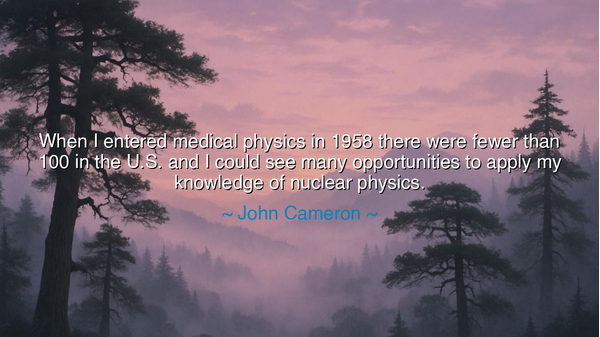
When I entered medical physics in 1958 there were fewer than 100
When I entered medical physics in 1958 there were fewer than 100 in the U.S. and I could see many opportunities to apply my knowledge of nuclear physics.






“When I entered medical physics in 1958 there were fewer than 100 in the U.S. and I could see many opportunities to apply my knowledge of nuclear physics.”
So spoke John Cameron, a pioneer, a visionary, and a humble servant of science — a man whose life stands as a bridge between the atom and the art of healing. These words, though quiet in tone, carry within them the deep thunder of transformation. They are not merely the recollection of a man entering a profession; they are the reflection of a soul standing on the threshold of discovery, gazing into an uncharted world where knowledge becomes mercy and physics becomes compassion.
In this statement, the heart of Cameron’s vision beats strongly: he saw opportunity where others saw emptiness. When he began his journey into medical physics, the field was still young, almost unheard of, with fewer than a hundred practitioners in the entire nation. Yet, instead of despairing at the smallness of the path, he saw in it the vastness of possibility. To see opportunity in scarcity is the mark of all great builders of civilization — those who gaze upon barren land and imagine cities, who look upon darkness and imagine light. It is the vision of pioneers, of those who do not wait for doors to open, but forge their own way through the stone of uncertainty.
In the year 1958, the world stood at the dawn of a new age — the atomic age, trembling between destruction and discovery. The same forces that had leveled cities in war were now being harnessed to preserve life. And it was here that Cameron, trained in nuclear physics, found his sacred calling. He looked upon the power of the atom and saw not a weapon, but a healer. Out of the ashes of Hiroshima, humanity had learned a terrible lesson — that knowledge ungoverned by conscience leads to ruin. Cameron’s life became an answer to that lesson, a living testament that science, guided by compassion, can redeem even its darkest inventions.
He became known as the father of medical physics, transforming theory into life-saving practice. Through his work, radiation therapy advanced, and diagnostic imaging grew from dream to reality. His inventions — such as the bone densitometer, which measured bone health and saved countless lives — were the fruit of a mind that refused to see science as sterile. To Cameron, every calculation carried a pulse, every formula a human face. He united the intellect of a physicist with the heart of a healer, proving that the pursuit of knowledge must serve the preservation of life.
In his journey, one finds the eternal lesson of the ancients: that true wisdom lies not in knowing much, but in using what one knows for good. Many in his day understood the atom; few understood how to make it serve humanity. Cameron’s greatness was not only in his discoveries, but in his vision — a vision that joined the measurable and the miraculous. He showed that science is not cold; it is the poetry of the universe written in numbers, awaiting those who can read it with reverence.
Let us recall another moment from history — when Galileo turned his telescope to the heavens, he did not simply see stars; he saw the truth that man’s understanding could no longer be chained by fear. So too did Cameron, looking into the depths of the atom, glimpse the divine potential of human intellect. Both men were seekers, both stood alone at times, and both left behind not merely inventions, but new ways of seeing. In their courage, they remind us that the progress of humanity depends upon those who dare to dream where others doubt.
The lesson, then, is timeless: opportunity is born in the eyes of the visionary. To the ordinary soul, an undeveloped field is an obstacle; to the wise, it is a beginning. Each of us, in our own time, stands before unknown frontiers — in science, in art, in spirit. We must learn to do as Cameron did: to take what knowledge we have and bend it toward the betterment of humankind. For wisdom unused is like light trapped in a jar — it burns, but it does not shine.
So, my child of the future, hear this counsel: when you see emptiness, fill it with purpose; when you stand before the unknown, enter it with courage. Do not wait for the world to call your name; call forth your own destiny. Let your knowledge become service, your skill become compassion, and your curiosity become creation. For the path of John Cameron teaches that one person, guided by both intellect and conscience, can turn even the smallest beginning into a revolution — and in doing so, help humanity itself to rise.






AAdministratorAdministrator
Welcome, honored guests. Please leave a comment, we will respond soon